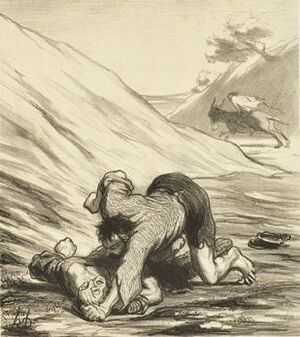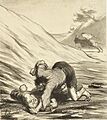The Lion, the Bear and the Fox facts for kids
The Lion, the Bear and the Fox is a famous story from Aesop's Fables. It's story number 147 in a collection called the Perry Index. This type of story is very old and can be found in many cultures, both in the East and the West. The main idea is always the same: two people or animals fight over something, and a third person or animal ends up taking it all.
Contents
The Story in the West
Ancient Greek versions of this fable exist. It was also in a collection of Aesop's fables from the 1470s called the Medici Manuscript. One of the first times it appeared in another language was in 1604. An Austrian poet named Pantaleon Candidus wrote it as fable number 60 in his collection of 150 Latin poems.
In Pantaleon's version, a strong lion and a big bear both attack a young fawn at the same time. They fight hard over the fawn until they are both too tired to move. A clever fox has been watching them. While the lion and bear are exhausted, the fox quickly grabs the fawn and runs away with it!
The lesson Pantaleon taught from this story was: Saepe alter alterius fruitur labribus. This means, "Often, someone else benefits from the hard work of others." This story then became popular in other printed collections of Aesop's fables.
Old Sayings and Other Tales
Many old stories in Europe share a similar idea. Two animals fight over something they found or caught, and then a third animal comes and steals it.
One of the oldest examples in English comes from Geoffrey Chaucer's The Knight's Tale (written around 1490). It talks about two dogs fighting over a bone. They fought all day, but neither of them got the bone. A bird called a kite flew by while they were angry and flew away with the bone.
This idea became a common saying: "While two dogs are fighting for a bone, a third runs away with it." In Dutch, they say, Als twee honden vechten om een been, loopt de derde om mee heen. This saying was even shown in a famous painting by Pieter Bruegel the Elder called Netherlandish Proverbs (1559).
La Fontaine's Version
The famous French storyteller La Fontaine changed this story in his book Les voleurs et l'âne (meaning "The Thieves and the Donkey"). In his tale, two thieves steal a donkey. They start fighting about whether to keep the donkey or sell it. While they are arguing, another thief comes along, hops on the donkey, and rides away with it!
La Fontaine used this story to teach a lesson about politics. He compared the thieves' fight to a war between Hungary and Turkey over a region called Transylvania. He showed how fighting among themselves could make both sides lose to a third party.
Lessons About Lawyers
Many versions of this fable, especially in the West, warn people about going to court. They suggest that when people argue over property and spend all their money on lawyers, a clever lawyer might end up taking the property for themselves.
For example, Samuel Croxall wrote in 1722 that when people go to law about something they own, "nothing is more common than for some little pettifogging attorney to step in, and secure it to himself." This means a small, tricky lawyer might take advantage and get the property. Thomas Bewick also shared this idea in his book Select Fables of Aesop (1784). He warned that "The intemperate rage of clients gives the lawyer an opportunity of seizing the property in dispute."
The Story in the East
Just like the saying about dogs fighting over a bone in England, India has a similar saying: "monkey's justice." This refers to a story where two cats fight over a piece of food, like bread or cheese. They ask a monkey to decide how to share it. The monkey cuts the food into two pieces, but they are never equal. So, he keeps nibbling a bit from one piece, then a bit from the other, to make them even. He does this until almost all the food is gone! The cats beg him to stop, but the monkey claims the rest as his fee and eats it all, leaving the cats with nothing.
A Hungarian folktale has a similar plot. Two bears argue over how to share a cheese, and they ask a fox to help them. The fox tricks them in the same way the monkey tricks the cats. This story was even made into a Russian cartoon in 1954.
Ancient Indian Tales
A very old Indian version of this story is found in Buddhist scriptures called the Dabbhapuppha Jataka. In this tale, two otters work together to catch a fish. They start arguing over how to share it. A jackal offers to help them divide the fish. The jackal gives the otters the head and the tail of the fish, but he runs off with the biggest part of the fish for himself!
The lesson from this Buddhist story is about politics:
-
-
-
-
- Just as when strife arises among men,
- They seek an arbiter: he's leader then,
- Their wealth decays and the king's coffers gain.
-
-
-
This means that when people fight and ask someone else to settle their argument, that person (like a king or leader) might end up gaining from their conflict. This story is similar to the fable of the Lion's Share, where one powerful animal takes most of the prey. This lesson has been used to talk about political problems, like the issues in India when it was ruled by the English, and later by Gandhi when India was divided in 1947.
Images for kids



